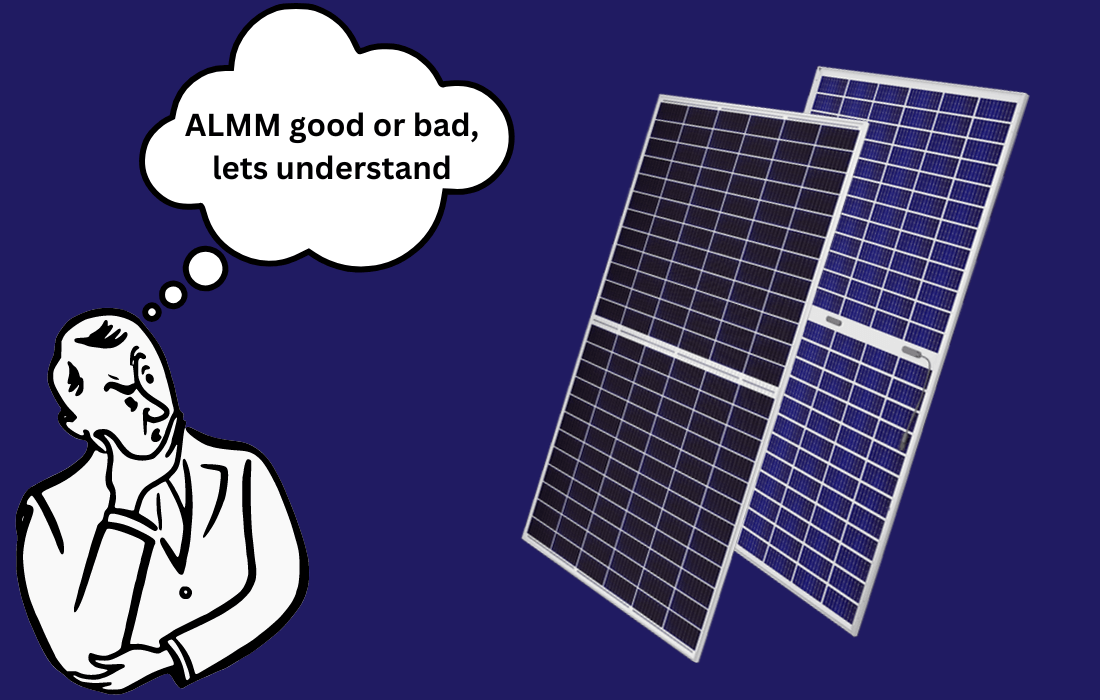For domestic module makers, project developers, and private PPA C&I clients, is the ALMM order beneficial or not? Beginning April 1, 2022,
The Ministry of New & Renewable Energy (MNRE) published the ‘Approved Models and Manufacturers of Solar Photovoltaic Modules Order, 2019’ on 02.01.2019 to secure the trustworthiness of Solar PV manufacturers, protect consumer interests, and promote the country’s greater energy security.
Click here to know “What is ALMM”?
ALMM, according to certain industry stakeholders, would not provide a significant benefit to the industry. Excessive application fees of INR 5,000 ($66 per MW) per MW capacity of cells and modules, levied individually, are prohibitively expensive for manufacturers, raising overall product costs and, subsequently, project expenses and electricity tariffs.
Furthermore, as part of the listing procedure for companies based outside of India, a large inspection fee is required to be paid for each of their manufacturing facilities. NISE has taken crores of rupees in application fees from various Tier-1 manufacturers over the last two years but has yet to issue an invoice or receipt for the money collected, raising suspicion.
Furthermore, the process of getting listed in the ALMM takes a long time, which could lead to project delays and supply chain disruptions.
This order enlists eligible prototypes and manufacturers of solar PV cells and modules that meet BIS Standards and publishes them in a list known as the Approved List of Models and Manufacturers. From April 1, 2022, the change will apply to open access and net metering programs.
On September 5, 2017, the MNRE released the “Solar Photovoltaics, Systems, Devices, and Components Goods (Requirements for Compulsory Registration) Order, 2017.” This order and other adjustments were made with the goal of ensuring the quality of solar cells and modules used in solar PV power plants, among other things.
Solar PV power plants, on the other hand, are put up for a specific period of time, and the solar PV cells and modules used in plants require a long-term warranty. It is preferable to verify that such products are manufactured in the units for which production claims have been made. Some facilities may claim to manufacture solar cells and modules that were manufactured elsewhere.
ALMM’s purpose is to physically determine the manufacturing unit, and it’s required for manufacturers who supply government-owned solar projects. This will be an addition to the government of India’s quality control, which is now confined to product testing by the Bureau of Indian Standards (BIS). The current BIS standards are backward and several levels below the global IEC 61215/61730: 2016 international standards (where BIS is still using ten-year-old and out-of-date IEC 61215/61730: 2005 & 2010 standards).
The unusual expense and time necessary to obtain newer, newest generation high-performance PV modules evaluated and approved for BIS is a huge disincentive, especially since only a few labs are accredited to conduct BIS testing.
This includes projects set up to sell electricity to the government in accordance with instructions published by the Center Government under section 63 of the Electricity Act, 2003 and amendments thereto. This enlistment is valid for two years and can be renewed with the proper documentation.
The ALMM order clearly states that the PV cells used in ALMM listed PV modules must be certified under ALMM List-II, and it’s commendable to notice that just a few of the ALMM listed PV modules employ M6, M10 mono PERC cells.
However, the failure of the MNRE to approve and publish List-II (the ALMM list of PV cells) raises the following severe concerns.
- How PV modules are approved in List-1, without approving PV cells in List-II (when it is MANDATORY to use ALMM listed PV cells in PV modules)?
- How are certain modules were approved with imported cells, when no overseas manufacturer of PV cells or Modules was inspected?
- If ALMM is implemented as proposed, how and from where the project developers are going to get ALLM-listed PV modules (using ALMM-listed PV cells), for the huge pipeline of projects that need to be grid-connected in 2022 & 2023?
- When there is no bid mfg capacity of PV cells in the country (except some outdated Polycrystalline PV cell mfg, there is no operating PV cell mfg plant that can produce high efficiency, high power Mono PERC, Bifacial PV cells) how ALMM is going to benefit even the domestic module manufacturers, who rely on imported PV cells (which are not yet ALMM listed).
This raises severe concerns about ALMM’s haphazard deployment, which benefits no one.
The Honorable Delhi High Court sought clarification from MNRE on what provisions they have made to protect ongoing projects at various stages that will be negatively impacted by the sudden extension of the ALMM on projects under net metering and open access, to which MNRE had no response and requested time to respond.
DISTRIBUTED SOLAR POWER ASSOCIATION, a registered and prominent association of renewable energy developers and IPPs operating in the field of renewable energy from solar, wind, and wind-solar hybrid for the C&I segment, has been actively working on the development of these segments and playing a constructive role in working with various ministries, policymakers, and regulatory bodies for the growth of this sector, filed the petition.
According to reports, MNRE issued an update to the office memorandum on “Approved List of Models and Manufactures” [ALMM] on January 13, 2022, which covered projects under open access and net metering for using ALMM approved solar modules that could be installed in just two and a half months.
Various developers, developers’ associations, and industry associations approached MNRE to clarify whether the same will apply to private projects developed for C&I consumers where no government subsidy / CFA is provided, and to provide adequate time for the amendment to be implemented so that ongoing projects are not impacted.
The developers were forced to explore legal remedies and seek relief from the Honourable Delhi High Court after receiving no response or confirmation from the ministry in this regard.
Surprisingly, the MNRE’s counsel had no response or instructions as to how the ongoing projects would be protected against such an injunction.
Private developers working in the C&I segment are already experiencing supply shortages and delays, and such sudden amendments have caused an artificial increase in solar module prices due to issues such as cartelization and demand and supply gaps within the country. On top of that, from April 1st, the duty on solar modules will increase from zero to 40%, which will be highly deterrent to the sector.
The more pressing issue is that more than 4 GW of open access and rooftop projects are in various phases of development, with open access / net metering permissions/agreements being granted in accordance with rules in order for the projects to be commissioned. All of these initiatives will become stalled, resulting in enormous financial losses for customers and developers.
C&I initiatives under open access and net metering, according to the developers, should be kept out of the scope of these regulations because they are not government-funded and/or receive subsidies. Furthermore, the current solar module supply are insufficient to even meet the needs of government-funded projects, causing these initiatives to suffer a significant delay. The country needs to build roughly 34 GW of solar panels every year, but its current capacity is only 10 GW, and not all module manufacturers pass reliability tests and are producing modules for commercial projects.
Foreign module manufacturers have stated that, despite proven track records and BIS certifications, and all documents, fees, and charges submitted to MNRE for the same for a long time, their modules could not be listed in the ALMM List because MNRE officials could not physically travel to their manufacturing facilities due to various reasons including travel advisories.
Prior to issuing such orders/amendments, the MNRE held no consultation meetings or solicited input from developers and consumers, relying solely on the recommendations of a few module manufacturers who also have control over cells to make these changes in a hurry, without delving deeply into the various associated aspects.
Developers remain hopeful that MNRE, which recognizes the gravity of the situation, will come up with a concrete solution to resolve this problem in the larger interest of the development of renewable energy and the sector as a whole, and that the amendment will be extended for at least one year until that time so that ongoing projects do not face a crisis.
At Solar is my Passion, we are keeping an eye on the progress of ALMM so that we you can understand it in a better way.


